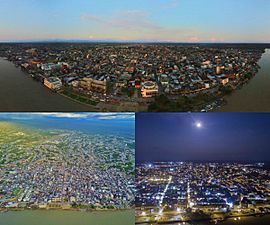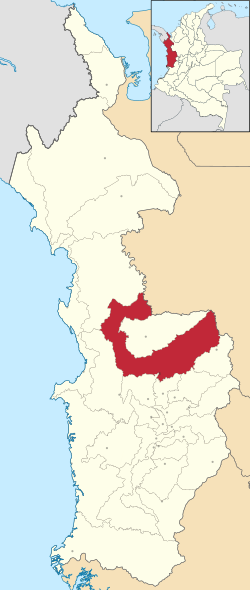Quibdó facts for kids
Quick facts for kids
Quibdó
|
|||
|---|---|---|---|
|
Municipality and town
|
|||

Aerial views
|
|||
|
|||
 |
|||
| Country | |||
| Region | Pacific Region | ||
| Department | Chocó Department | ||
| Founded | 1648 | ||
| Area | |||
| • Municipality and town | 3,507 km2 (1,354 sq mi) | ||
| • Urban | 28.71 km2 (11.08 sq mi) | ||
| Elevation | 43 m (141 ft) | ||
| Population
(2018 census)
|
|||
| • Municipality and town | 129,237 | ||
| • Density | 36.851/km2 (95.444/sq mi) | ||
| • Urban | 113,124 | ||
| • Urban density | 3,940.2/km2 (10,205.1/sq mi) | ||
| Time zone | UTC-05 (Colombia Standard Time) | ||
| Area code(s) | 57 + 4 | ||
| Website | Official website: http://www.quibdo-choco.gov.co/ | ||
Quibdó is the main city and capital of the Chocó Department in Colombia. It is located in the Pacific Region of the country, right on the Atrato River. The area of Quibdó is about 3,507 square kilometers. Around 129,237 people live here. Most residents are of Afro-Colombian heritage.
Contents
History of Quibdó
Early Times and Spanish Arrival
Long ago, the thick rainforests and mountains of Chocó were a huge natural wall. This wall separated the ancient civilizations of Central America and the Andes. The weather here is very rainy and humid. Because of this, Spanish explorers were not very interested in settling down.
In 1648, the Emberá Indians gave a lot of their land to the Spanish Franciscan religious group. But other local tribes attacked the new Spanish settlements. This made it hard for the Spanish to build towns. Six years later, the Spanish tried again to settle the area. They started some lumber camps and farms. They forced enslaved Africans to work there.
Finding a Route and Discovering Riches
In the 1800s, people became interested in finding a way to sail between the Atlantic and Pacific Oceans. This would avoid the long trip around South America through the Straits of Magellan. The Atrato River Valley in Chocó seemed like the best option. A famous explorer, Alexander von Humboldt, thought so too. However, this idea was later dropped when the Panama Canal was built instead.
Around the same time, gold and platinum were found in the Atrato Valley. This discovery helped Quibdó grow a lot. It became the most important town in the region.
Life for Freed Slaves and Economic Changes
After slavery ended, many freed black people moved to Chocó. They often used a farming method called "shifting cultivation." This helped them deal with the very wet climate, which washes away nutrients from the soil. They also fished and gathered products from the forest.
In 1853, an artist named Manuel María Paz painted pictures of Quibdó. These paintings show people of mixed heritage and Europeans. They also show Afro-Colombian street vendors and women in the town square.
The Afro-Colombian communities traded with cities in the highlands, like Medellín. They used rough mule trails until the 1950s. Over time, the population grew, but the value of the region's natural resources went down. This led to a difficult economic period for Quibdó and the whole region.
Climate in Quibdó
Quibdó has an extremely wet and cloudy tropical rainforest climate. This means it does not have clear seasons like summer or winter. It receives more rainfall than any other city of its size or larger in South America. For example, Monrovia in Liberia, a city with a lot of rain, gets about 3,050 millimeters less rain each year than Quibdó.
Why So Much Rain?
The huge amount of rain happens for a few reasons:
- The Andes mountains are to the east of Quibdó. They block the winds coming from the west.
- These winds are pushed by something called the Intertropical Convergence Zone. This zone stays in the north of South America near Quibdó all year.
- The air from this zone is very unstable and rises over the Chocó plain. As it rises and cools, it releases huge amounts of moisture as rain.
- Also, the rich nature and many different plants and animals in the region create a "biotic pump" effect. This helps pull even more moisture from the Pacific Ocean into the Colombian Andes.
It rains almost every day in Quibdó. The rain often comes in strong thunderstorms. About 309 days (84%) of the year are rainy days. Sunny periods usually last only a few hours after the sun comes up. Quibdó gets only about 1,276 hours of sunshine each year. This makes it one of the cloudiest cities in the world. July is its sunniest month, with about 135 hours of sunshine.
| Climate data for Quibdó (Aeropuerto El Caraño) | |||||||||||||
|---|---|---|---|---|---|---|---|---|---|---|---|---|---|
| Month | Jan | Feb | Mar | Apr | May | Jun | Jul | Aug | Sep | Oct | Nov | Dec | Year |
| Record high °C (°F) | 36.6 (97.9) |
35.0 (95.0) |
35.4 (95.7) |
37.0 (98.6) |
35.0 (95.0) |
38.0 (100.4) |
36.8 (98.2) |
35.4 (95.7) |
35.0 (95.0) |
34.8 (94.6) |
35.4 (95.7) |
35.6 (96.1) |
38.0 (100.4) |
| Mean daily maximum °C (°F) | 30.1 (86.2) |
30.2 (86.4) |
30.4 (86.7) |
30.8 (87.4) |
31.0 (87.8) |
31.2 (88.2) |
31.1 (88.0) |
31.0 (87.8) |
30.7 (87.3) |
30.4 (86.7) |
30.2 (86.4) |
29.6 (85.3) |
30.6 (87.1) |
| Daily mean °C (°F) | 26.2 (79.2) |
26.4 (79.5) |
26.6 (79.9) |
26.6 (79.9) |
26.7 (80.1) |
26.6 (79.9) |
26.6 (79.9) |
26.4 (79.5) |
26.2 (79.2) |
26.0 (78.8) |
26.0 (78.8) |
26.0 (78.8) |
26.4 (79.5) |
| Mean daily minimum °C (°F) | 23.0 (73.4) |
23.1 (73.6) |
23.2 (73.8) |
23.4 (74.1) |
23.2 (73.8) |
23.0 (73.4) |
22.8 (73.0) |
22.9 (73.2) |
22.8 (73.0) |
22.7 (72.9) |
22.8 (73.0) |
23.0 (73.4) |
23.0 (73.4) |
| Record low °C (°F) | 19.0 (66.2) |
21.0 (69.8) |
20.8 (69.4) |
20.0 (68.0) |
20.0 (68.0) |
19.0 (66.2) |
19.8 (67.6) |
19.6 (67.3) |
20.0 (68.0) |
18.0 (64.4) |
20.0 (68.0) |
20.0 (68.0) |
18.0 (64.4) |
| Average rainfall mm (inches) | 579.3 (22.81) |
505.4 (19.90) |
526.1 (20.71) |
654.6 (25.77) |
776.2 (30.56) |
761.6 (29.98) |
802.6 (31.60) |
851.7 (33.53) |
702.4 (27.65) |
654.0 (25.75) |
728.1 (28.67) |
588.5 (23.17) |
8,130.5 (320.1) |
| Average rainy days | 24 | 21 | 22 | 25 | 27 | 26 | 26 | 27 | 27 | 27 | 26 | 26 | 304 |
| Average relative humidity (%) | 88 | 86 | 86 | 88 | 87 | 87 | 86 | 87 | 87 | 88 | 88 | 89 | 87 |
| Mean monthly sunshine hours | 90.5 | 83.4 | 85.6 | 92.9 | 112.5 | 114 | 135.1 | 132.7 | 112.7 | 116.7 | 112.2 | 88.1 | 1,276.4 |
| Source: INSTITUTO DE HIDROLOGIA METEOROLOGIA Y ESTUDIOS AMBIENTALES | |||||||||||||
Transportation
Quibdó has an airport called El Caraño Airport. Three different airlines offer flights there.
Famous People from Quibdó
- Vanessa Mendoza (born 1981), a politician and the first black Miss Colombia.
- Jackson Martínez (born 1986), a former professional football (soccer) player who played as a striker.
- Elvis Rivas (born 1987), a football (soccer) player.
- Wbeymar Angulo (born 1992), a professional football (soccer) player for the Armenia national football team.
- Andrea Tovar (born 1993), a model and Miss Colombia 2015-2016.
- Edwin Mosquera (born 2001), a professional football (soccer) player for Atlanta United.
See also
 In Spanish: Quibdó para niños
In Spanish: Quibdó para niños



